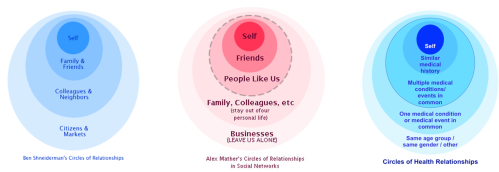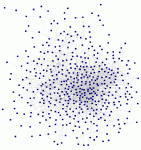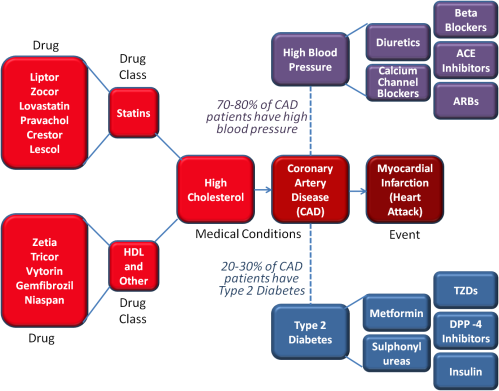Lack of a True Health Social Layer
There is currently no true social layer in health akin to the Social Graph for social connections. Most of the successful health networks or health communities that exist today make connections based on one significant characteristic of users, typically one specific medical condition (e.g. Type 1 Diabetes or ALS). What needs to evolve is a true health network layer (the Health Graph) that organizes users based on multiple data points and connects people based on a high degree of similarity between users (and thus relevance).
People typically organize themselves (offline and online) based on the number of things they have in common, or some specifically strong tie (i.e. family):
 Since we cannot see health characteristics and experiences, we cannot see whom we should ask for advice, insight or understanding of health questions. Of course one of the great promises of the Health 2.0 movement is that technology will facilitate this ability in health.
Since we cannot see health characteristics and experiences, we cannot see whom we should ask for advice, insight or understanding of health questions. Of course one of the great promises of the Health 2.0 movement is that technology will facilitate this ability in health.
Turning Health Data into Information – The Health Graph
I previously wrote a post about the details one can learn about a person from a few health data points, in that case medication history. Taking this concept a step further, I think that with a few simple data points from each individual in a population (i.e. age, gender, BMI, medical conditions, medications/treatments, medical events, or any subset of these data), it is possible to map any individual in context (similarity and dissimilarity) to all other members in that population. Mapping users based on heath data is facilitated because many of these data points are inherently connected:
In the example above Zocor (simvastatin) (drug) implies high cholesterol (medical condition), which implies cardiovascular disease (disease system). Lipitor (atorvastatin) also implies high cholesterol and cardiovascular disease. A heart attack (event) implies coronary artery disease (medical condition), which implies high cholesterol, which implies cardiovascular disease. So, someone on simvastatin is inherently related to someone on atorvastatin, and both are indirectly related, (whether they like it or not) to someone who has had a heart attack (severe manifestation of same disease).
Due to the inherent connectedness of these data points, a meaningful health profile can be built for a user with only a few points and some educated assumptions. Of course then you can layer in relationships between other medical conditions and data points, and begin to include attitudinal characteristics. The more points you have in common with another user, the more similar you are to that user, and the closer you are to that user in the Health Graph. This Health Graph will become stronger and more robust with each additional user and/or data point added.
Once you know these basic health characteristics for each member of a population and map them in relation to other members, you can create a true network, a true health social layer, and a strong platform for personalized services, features and “social health applications” (discussed in greater detail in Part 2 of this post).
One of the key benefits of the Health Graph is the ability to create meaningful peer groups based on multiple dimensions. As an example, knowing only a user’s chronic medical conditions allows segmentation into meaningful ‘verticals’. In the diagram below, even though all users share some attribute with another user, users 1 and 3 are more similar to each other than to 2,4,5. Note that non-shared characteristics (diabetes) also differentiate patients.
Limitations of Current Health Networks
I think it is interesting that the most successful health networks to date (PatientsLikeMe, type 1 diabetes networks, oncology networks such as ACOR, etc.) are really targeting the “tail”, meaning they are indications with small numbers of patients (compared to high cholesterol or type 2 diabetes), but where that one indication has a significant impact on the user’s life. For these patients, these networks are imensely valuable. But for patients without this ‘defining health characteristic’, no true network exists.
In truth, however, the majority of people are complex, made of many equally relevant factors that make up the whole. The successful companies targeting this complex audience have historically focused on content (WebMD) or on Q&A forums (MedHelp), where the user must know what they are searching for or to which ‘forum’ to post a question.
Future of the Health Graph
In the future, the health info needed to add a new user to the Health Graph will be pulled down effortlessly from some other source (like HealthVault, Google Health, Blue Button Initiative, PracticeFusion, etc.), but for now, this is a non-trivial task, and early adopters must enter this data. But I am pretty sure that whoever can attract the early adopters, begin to build this Health Graph and build engaging features on top of the Graph will be pretty successful when the second wave of users can join with the simple push of a Blue Button.



I’m fascinated by the idea of building automatic condition specific health networks based on prescription claims… A person discovery system with integrated health and social data would be powerful.
Chris,
Thanks for the comment. I think Rx claims and prescription drug histories are really powerful. Check out another post i wrote on this topic (http://bit.ly/bZOvrN). i am very interested in the amount you can learn about somebody (and thus target highly relevant content, connections) based on just a few data points and an understanding of how they are related.
Look forward to speaking with you more about it.
Chris
Interesting! Just to add that location is extremely important. Of course, income is one of the biggest determinants of health status.
Thanks Anne Marie. I agree that a lot of ‘non-typical’ health data points will need to be included to complete the picture. I think it would be interesting to have this complete data set, define a test population using multiple data points, so that they are remarkably ‘similar’ from baseline, then analyze this set using location or income as the test variable. basically prospectively demonstrate the impact of these variables on other health metrics in a very large population. Thanks for your comment.
Have you ever considered publishing an e-book or guest authoring on other websites?
I have a blog centered on the same subjects you discuss and
would love to have you share some stories/information.
I know my audience would value your work. If you are even remotely interested, feel free to shoot me an e-mail.
These, nevertheless, call for a preposterous
quantity of luck and are hard to appear by. Sweet Crush is an really common recreation currently staying performed on mobile gadgets,
tablets and desktops. But, compared with the typical sugar laden chocolate coated raisins this coronary heart healthier option is absolutely nothing to experience guilty about indulging in.
Most of those suffering from this disease complain of weakness, giddiness, and
body ache. Portion Size Experiment – Get a three-section plate and eat your
biggest meal on it. Usually, for most women there are
no signs of symptoms.
Wonderful goods from you, man. I’ve understand your stuff previous to and you’re just
extremely great. I really like what you’ve acquired here,
really like what you are stating and the way in which you say it.
You make it enjoyable and you still take care of to keep it wise.
I can’t wait to read much more from you. This is actually a
wonderful site.